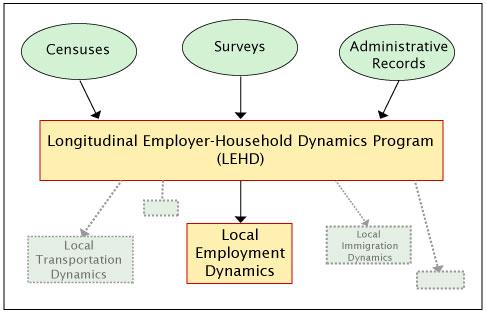| Skip this top of page navigation
|
|
|
|
|||||||||||||||||
|
|
|
|
||||||||||||||||||
|
|
|
|||||||||||||||||||
|
|
|
|||||||||||||||||||
|
|
|
Mission | FAQs | Staff | Contact | Directions
|
|
|||||||||||||||||
|
|
|
|||||||||||||||||||
Frequenly Asked Questions
Longitudinal Employer-Household Dynamics (LEHD) is an innovative program within the U.S. Census Bureau. We use modern statistical and computing techniques to combine federal and state administrative data on employers and employees with core Census Bureau censuses and surveys while protecting the confidentiality of people and firms that provide the data. Local Employment Dynamics (LED) is a voluntary partnership between state labor market information agencies and the U.S. Census Bureau to develop new information about local labor market conditions at low cost, with no added respondent burden, and with the same confidentiality protections afforded census and survey data. What is the difference between LEHD and LED?
The Quarterly Workforce Indicators (QWI) are a set of economic indicators—including employment, job creation, wages, and worker turnover—that can be queried by different levels of geography—state, county, metro, and workforce investment area—as well as by detailed industry, gender, and age of workers. You can query the data directly by using the QWI Online tool on this site. Why aren't QWI data available for all states? All 50 states, the District of Columbia, Puerto Rico, and the U.S. Virgin Islands have been in the LED partnership since December, 2010. However, not every state partner has passed through the experimental production phase. In addition, individual state partners may periodically be put on production hold because of issues that are encountered in submission of new data files, and some state partners may occasionally miss their file submission. These infrequent occurrences also create a lag in data availability. What types of employment are included in the QWI? The QWI are built upon wage records in the Unemployment Insurance (UI) system and information from state ES-202 data. The universe of QWI data is UI-covered earnings. UI coverage is broad, covering over 90% of total wage and salary civilian jobs. When QWI private industry employment numbers are compared with other employment data, exclusions to UI coverage should be taken into account. Federal government employment is not generally included. Exempted employment varies slightly from state to state due to variations in state unemployment laws, but generally also excludes many farmers and agricultural employees, domestic workers, self-employed non-agricultural workers, members of the Armed Services, some state and local government employees as well as certain types of nonprofit employers andreligious organizations (which are given a choice of coverage or noncoverage in a number of states). A more in-depth discussion of UI-coverage issues is available in the technical paper "Employment that is not covered by state unemployment" [PDF; File Size: 218KB]. I'm looking at some QWI data and see that some numbers have been flagged with codes—what do these codes mean? The LED program uses noise addition methodology to protect tabular information. These flags indicate data cells that have had noise added or have been suppressed to protect the confidentially of reporting units. More information on these techniques can be found under the discussion of confidentiality on this site. The following is a summary of the codes used in the QWI:
Is there a data dictionary available for the QWI? A list of detailed definitions for the variables on QWI Online can be found in Appendix A in Abowd, Stephens and Vilhuber (2006) technical documentation paper [PDF; File Size: 760KB]. For a simple list of definitions, view Appendix A [PDF; File Size: 272KB]. For a more general and less detailed list of definitions, a less comprehensive list of definitions [PDF; File Size: 76KB] provided by Cynthia Tauber and Erika McEntarfer is also available. Can I download all the QWI data for a county from the website? You can download the 8 indicators that are available on the website using the following steps:
Does the PUMS issue have an impact on LED data? The Local Employment Dynamics (LED) Program is aware of the concerns that users of Census Bureau-produced public-use micro-data samples (PUMS) have regarding the issues raised by Trent Alexander, Michael Davern, and Betsey Stevenson in their paper "Inaccurate Age and Sex Data in the Census PUMS files: Evidence and Implications". Reports by Justin Wolfers in the New York Times and Carl Bialik in the Wall Street Journal have brought this technical paper, which was released last summer at the 2009 Joint Statistical Meetings in Washington, DC, to the attention of many data users and the general public. The LED Program data products—Quarterly Workforce Indicators, OnTheMap, QWI Online, Industry Focus, Older Worker Profiles, and CED HotReport—do not use any of the Census 2000 or American Community Survey public-use micro-data samples that are affected by the disclosure avoidance problems noted by Alexander, Davern, and Stevenson. The issues raised by those authors concern only the PUMS files produced from confidential Census Bureau data, not the underlying data themselves. Internal confidential Census Bureau files, used for all LED products, were not affected. All LED products use tested disclosure avoidance methods that reliably reproduce age and sex distributions of employed workers in the sub-populations for which we publish data. Questions or comments should be sent to CES.Local.Employment.Dynamics@census.gov. Copy of Statement
[PDF] or | ||||||||||||||||||||
|
|
||||||||||||||||||||
|
|
|
|
|
|
|
|
|
|
||||||||||||
